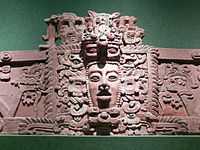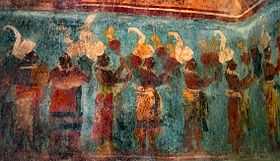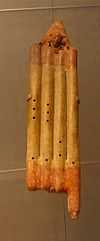Maya music
 |
| Maya civilization |
|---|
| History |
| Preclassic Maya |
| Classic Maya collapse |
| Spanish conquest of the Maya |
The music of the ancient Mayan courts is known through descriptions in native and Spanish 16th-century texts and the depiction of performances in the art of the Classic Period (200-900 AD). Many instruments have come to light, so that tonal reach and scales can be studied, but no musical notation has survived, and the music itself disappeared after the dissolution of the Maya courts following the Spanish Conquest. Music played a vital role in the public rituals and ceremonies, with instruments being grouped into orchestral sections.


Instruments
Not counting the human voice, there existed only two classes of instruments, wind and percussion, further divided into flutes and whistles; trumpets; rattles (maracas); bone and gourd rasps; and drums. In more detail:
Flutes
Flutes were made of wood, bone, reed, or clay, with one or several tubes. Among the ceramic flutes are also effigy flutes, just as vessel flutes (ocarinas) are often shaped like a figurine. In Classical vase painting, flutes are only infrequently depicted.
Trumpets
Long trumpets were, amongst other things, used to announce visitors and accompany the king on his state visits.[1] They could have gourds set at the end of the tube as resonance chambers.[2] Among the trumpets were also conches, which had a role to play in hunting deer, in warfare, and probably in ritual as well.
Rattles
Rattles (maracas) were usually made from gourds, but archaeological evidence from Pacbitun, Belize, shows that sophisticated forms of maracas, along with the small balls inside, were also crafted in fired ceramic materials. In the same find, archaeologists discovered ceremonial flutes and ocarinas similarly crafted out of fired ceramic.[3]
Drums
Large vertical drums (which the Aztecs called huehuetl) were made of wood and have not survived. The much lower standing kettle drums that have been found - often shaped like a bulbous jar on a pedestal, single or double - are earthenware. In depictions, the membrane is sometimes shown to consist of a jaguar pelt. In the Late-Postclassic Dresden Codex (34a), the drum connects to an open resonance chamber without membrane. Another type of kettle drum was portable and held under the arm.[4] The horizontal slit-drums (tun, Aztec teponaztli) appear only after the close of the Classic Period, probably under Toltec influence. In addition there were tortoiseshell and turtleshell drums played with the hand (Herrera), or with a stick such as a deer antler.
There is a noteworthy continuity in the use of some of these Classic Period instruments. In the battle of Ake, Yucatán, for example, Francisco de Montejo's troops noticed warriors blowing whistles, "and beating the shells of great turtles with deer horns, and [blowing] trumpets of large conch-shells of the sea."[5] Around 1900, the Lacandons still used bulbous kettle drums, often paired, and conch trumpets, "blown in a single note," to invite the deities to partake of the offerings.[6]

Performance
Theatrical events, dance, ritual, and, to a lesser extent, even warfare would have been unthinkable without musical support.[7] Therefore, the musical director in Yucatán, the holpop, was held in high esteem.[8] Maya dictionaries, both ancient and more recent, contain many words and distinctions related to music, such as, for example, Ch'orti' lahb "stroke [a drum] with the dexterity of a tortilla maker."[9]
Particularly the drums, whether the slit-drum, the kettle drum, or the high wooden drum, appear with specific rhythmical motifs to have initiated the musical performances, or, as Gerónimo de Mendieta states in writing about the native music of New Spain, "when the dancers hear that the kettle drums [atabales] start, they understand by their tone the song and the dance, and then start it."[10]
According to Cogolludo, the holpop was not only "the principal singer who sets the key and teaches what is necessary to sing," but also the keeper of the musical instruments, first of all the [horizontal] tunkul drums.[11] In the Rabinal Achí, a Highland Maya 'tun-dance' drama dating back to the 16th century, the stage and music director is usually the one who plays the ancient wooden slit-drum (tun), accompanied by two trumpets.
The most complete depiction of a Classical period musical performance is that on the lower walls of a Bonampak temple room (room 1). Dating back to AD 791, it shows a royal dance accompanied by a file of twelve musicians divided into sections: pairs of large rattles (5 players) - a high, vertical drum (1 player) - large, portable turtle/tortoise drums played with sticks (3 players) - long trumpets (2 players) - rattle and ocarina (1 player). In between the turtle drums and the trumpets is a group of five theatrical impersonators surrounding a young nobleman. The trumpets may have started, with the standing drum then assuming the lead part.
Religious aspects
The 16th-century Quiché-Maya hero myth of the Popol Vuh stages the brothers Hun-Batz and Hun-Choven as flautists and singers, while describing them as patrons of the other arts as well; the Hero Twins transform them into monkeys by playing the flute and the drum and by singing a certain tune.[12] The musical Elder Brethren correspond to the Howler Monkey Gods of the Classic period. In the Classic and Late-Preclassic Periods, the Tonsured Maize God - another deity of the arts - is intimately connected to a small, portable turtle drum; the deity of the day Ik' (Wind) is sometimes shown shaking rattles.
Notes
References
- Cheong, Kong F. (2012) 'A Description of the Ceramic Musical Instruments Excavated from the North Group of Pacbitun, Belize', in Terry G. Powis ed., Pacbitun Regional Archaeological Project, Report on the 2011 Field Season. Institute of Archaeology, Belmopan, Belize.
- Houston, Stephen et al. (2006) The Memory of Bones: Body, Being and Experience Among the Classic Maya. University of Texas Press, Houston, ISBN 978-0-292-71294-2.
- Looper, Matthew G. (2009) To Be Like Gods: Dance in Ancient Maya Civilization. U. of Texas Press, Austin.
- Mendieta, Gerónimo de (1870) Historia Eclesiástica Indiana (ed. Joaquín García Icazbalceta). México: Antigua Librería.
- Rodens, Vanessa (2006) 'U bah tu yal pat. Tambores de parche mayas prehispánicos'. Tradiciones de Guatemala 66: 51-62.
- Sharer, Robert J. (2005) The Ancient Maya. Stanford U.P.
- Stone, Andrea, and Marc Zender (2011) Reading Maya Art. Thames & Hudson.
- Tedlock, Dennis (tr.) (1996) Popol Vuh: The Mayan Book of the Dawn of Life. Simon & Schuster, New York.
- Tozzer, Alfred M. (1907) A Comparative Study of the Mayas and the Lacandones. The Macmillan Company, New York.
- Tozzer, Alfred M. (1941) Landa's Relación de las cosas de Yucatán. A Translation. Peabody Museum, Cambridge MA 1941.
Further reading
- "Archaeology Magazine" editors (2002) Secrets of the Maya. Hatherleigh Press, Long Island City, NY, ISBN 1-57826-123-6.
- Bourg, Cameron Hideo (2005) Maya Music Now with Sound. MA Thesis, Louisiana State University.
- Hammond, Norman (1972) 'Classic Maya Music. Part 1, Maya Drums; Part 2, Rattles, Shakers, Raspers, Wind, and String Instruments'. Archaeology 25(2, 3): 124-131, 222-228.
- Sadie, Stanley (2001) The New Grove: Dictionary of Music and Musicians. Second Edition Vol. 16, MacMillan Publishers Limited.
- Stevenson, Robert (1971) Music in Mexico: A Historical Survey.
| ||||||||||
| ||||||||||||||||||||||||||||||||||